It’s always a pleasure to find ways to increase your garden yield while reducing your labor, time, and cost outputs. Luckily, guilds are another great way to do this – providing you with high-quality, diverse yields – with less work.
By planting in patterns to benefit from companion planting and forest gardening, guilds use plants as an integrated self-balancing management system to protect and support your crops. The result is healthy, more fruitful plants and bigger high-quality yields, with less time spent on hard graft and crisis management.
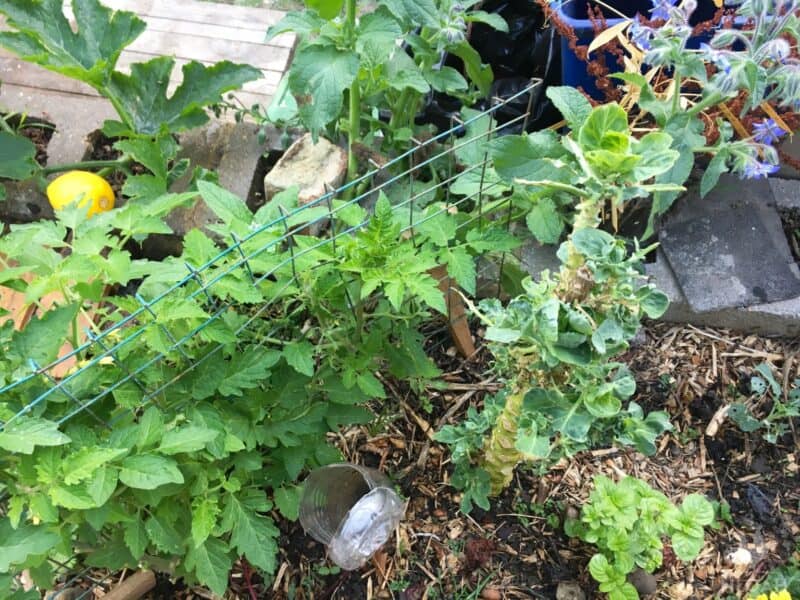
If you’d like to learn about guilds, how to build them, and how they work – read on! This guide is for you!
Table of Contents:
What is a Guild?
A guild is a collection of plants that work together to enhance each other through their various natural functions – providing physical support, extra nutrients, protection, and so on.
Guilds are a popular design for plant selection and placement in permaculture as their pattern mimics nature’s own blueprint for regenerative design.
By planting in guilds, we’re able to substantially increase and diversify our yield, while reducing our labor, time, and cost output.
As food growers, when we plant our gardens, we aim to minimize input and maximize output without creating waste. When we observe a forest – we see this very process in action.
With that in mind, we understand that mimicking the forest’s organization and behavior will produce strong, healthy, abundant, diverse yields from our gardens.
Guilds aim to copycat forest patterns. In a forest, we see anchor species – trees and plants that serve as the central focal point for natural-occurring plant guilds.
Surrounding these anchor trees, a variety of plants and fungi arise, providing and receiving support from the anchor tree in many ways – deterring pests, attracting pollinators, providing shade, etc.
These supporting plants not only serve many useful functions, they also work with time and space to fit a lot of different plants in. Naturally occurring forest guilds tend to have up to 7 layers of diverse plants around it at any one time – cleverly utilizing the space, while changing with the seasons and cycle to make way for new species.
When we use this 7-layer planting pattern in our gardens, we generally call this ‘Forest Gardening’. Guilds leverage this 7-layer toolkit for plant selection to make the most of space and time in our gardens, while also serving as a map to indicate the functions various plants serve to the anchor.
The 7 Layers of Forest Gardening Are:
- Canopy/Overstory – Tall trees usually for timber, but could be large fruit/nut trees
- Understory – Smaller trees, usually fruit and nut trees, but can be coppice for firewood
- Shrub/Brush – Hard-stemmed bushes such as rosemary, oregano, berries, and kindling
- Herbaceous – Soft-stemmed bushier herbs, flowers, and vegetables
- Groundcover – Low-level herbs and salad leaves to insulate and protect the soil
- Rhizome/Root – Edible crops like potatoes, garlic, onions, turnips, turmeric, and ginger
- Vine/Creeper – Vertical layer for vine fruits, vegetables, and herbs like sugar snap beans, hardy kiwi, butterfly pea and small melons.
The second concept we use is companion planting. In a guild, the anchor plant is surrounded by companion species that help to benefit our anchor in some way.
In order to determine which plants to select, we find the most supportive companions to the anchor – usually a fruit tree or main crop (like a tomato).
You can head here to check out our companion planting guides.
In short, a guild is a way of planting your main crops alongside other supportive companion species. Harnessing the 7-layers of the forest, you can increase your yields on a smaller footprint, while diversifying your returns and ensuring a more resilient, self-supporting system to protect your main crops.
How To Build a Guild
Firstly, when building a guild it is important to design before planting, as you need to consider both time and space. In general, this is easiest done beforehand.
Step 1. Choose your anchor
Start by working out which anchor you want to work with. The companions you choose will vary depending on what your anchor produces and its requirements (sun/water/soil).
Step 2. Know your location
You need to understand where you’ll be placing your anchor and design the rest of the plant selection around that location.
It is always a good idea to take some observations from the site where you plan to place your guild. This helps you to understand how your companions can best support the anchor plant.
Step 3. Think about the existing problems
This may take some research. Consider all the problems you may encounter first and match them to a plant that can solve this – this is greatly helped if you have taken observations from the planting location (i.e water flow, sun, soil type, weed patterns, etc).
Make sure you consider problems with little or too much water, little or too much shade, poor soil, rampant pests, aggressive weeds, and heavy fruits or nuts from the anchor.
QUICK TIP: The weeds in the soil will tell you a tale about the existing issues. If you have water-loving weeds, likely rain collects here and the drainage isn’t good. If you have nitrogen-fixing clover or nettles, you know the soil needs nitrogen. If you have a bunch of taproots like mullein, green alkanet and dandelion, you know the topsoil needs minerals.
The companions you choose should aim to manage and tackle these issues. You want more than one plant to serve each function – i.e multiple plants for pest management, weed suppression, soil protection and so on.
EXAMPLE: The Three Sisters. Corn, beans, squash – Corn works as a trellis for the beans, and can serve as a wind barrier. The beans put nitrogen in the soil and the squash’s large leaves suppress weeds and protect the soil.
Step 4. Consider space
Using the 7-layer forest gardening system, you want to slot your companions into the physical space in the design.
Suppose your anchor is an apple tree and you need a nitrogen fixer – so you choose a climbing pea to save space by traveling up the trunk. Maybe you’d like to loosen the soil to help your plant’s roots anchor down, so you introduce some carrots below the soil to utilize space.
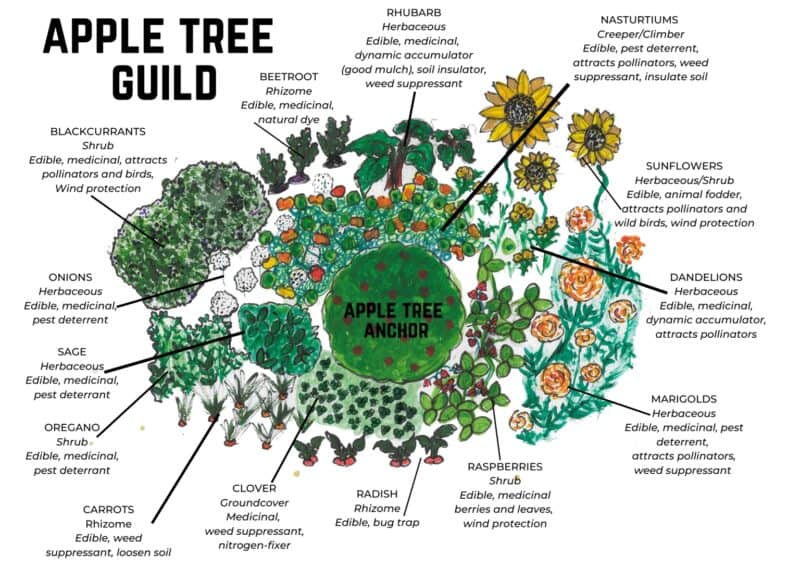
It is important when you work with layers, that you consider the sun’s movement as you don’t want to shade out crops. Bigger bushes may block the sun and need to be placed behind your anchor vegetables.
Try to have at least one species of plant for each layer, but you don’t want too many at each layer at any one time or they’ll be overcrowded at another.
Step 5. Don’t forget time
Your planting and harvesting times range for different species. When you’re planting, it is wise to consider mostly planting perennials to lighten your load on the maintenance side. However, you need to think about when they may bear fruit.
If you are wise, you can maximize your yield using crop rotation – harnessing the benefits of the plant that came before it – such as potatoes loosening soil for leeks and onions to follow; or sowing peas and beans to provide nitrogen in the soil for the brassicas that follow.
Step 6. The Rule of Three
As you can’t plant all your options, you need to choose by selecting the most effective plants for your guild.
Some people like to use the rule of three – the plant has to have at least 3 functions to be included in the guild. It’s also a good idea to make sure all functions are served by at least 3 plants (or elements).
Step 7. Dig Your Bed
Guilds can be any size, from indoor plant pots to big tree guilds. The size doesn’t matter – the pattern does.
In general, when building a guild, you want your anchor crop in the middle of a raised bed. This is often achieved by excavating around the anchor a little – you create a ditch to collect rainwater water.
If the guild is surrounding a tree on a hill, the excavated soil is placed on the downside of the hill – creating a flat terrace for the anchor crop, while also creating a berm as a barrier to collect rainwater.
Step 8. Mulch the Ditch
If you dig a basin around your anchor species, make sure you mulch this. On the one hand, it brings it to the level of the anchor so no roots get exposed. Secondly, it holds more water, and thirdly, it provides a sunken bed to plant guild crops into.
Step 9. Plant Your Guild
Your companion plants are organized according to sunlight, water, and spatial needs around your anchor – taking into account their functions.
How Do Guilds Work?
Guilds work to provide high-quality, diverse edible and medicinal yields for us, while also thriving in a self-perpetuating system of interspecies support.
Guilds Increase High Quality, Diverse Food/Medicine/Materials
By planting guilds, we’re not only able to enhance the environment for our main crop – therefore increasing its yield – we’re also able to diversify our diet while increasing our return.
This works twofold. On the one hand, by planting edible and medicinal companions with our anchor crops, we literally increase the kilos of food we get back as we have more doos/medicine/resource-bearing plants.
On the other hand, by planting supporting species next to our anchor crops, we increase the productivity and quality of that main crop – again increasing the quantity and nutritional value of the yield.
By planting a variety of plants together, such as dill, garlic, beans, and fruit trees – also known as companion planting – you not only get the satisfaction of seeing diverse vegetation spread throughout your garden but also attract wildlife like deer and other pollinators like bees and butterflies.
You’ll attract beneficial insects so you can rely far less on insect repellents and other chemicals.
Plus, members of the plant guild can protect one another by drawing pest insects away from neighboring crop plants, thereby allowing more nutrition to be produced in less space.
Plant guilds embody permaculture principles that can provide significant rewards for any home gardener or farmer both economically and environmentally.
Guilds Regenerate the Soil
Plants need nutrients, which get made via the natural cycle of decomposition and growth in nature. As does the forest, guilds look to house species that work together, bringing diverse functions to the table in order to regenerate the soil.
For example, legumes – such as clover, peas and beans – fix nitrogen in the soil by absorbing nitrogen from the air and putting it into the topsoil via leaf drop.
Equally, tap-rooted plants reach far down into the soil and harvest minerals that are untouchable to many short-rooted plants. These species disperse these minerals into the topsoil for other plants – namely your anchor crops – to reach via leaf drop.
These are plants that are known as “dynamic accumulators”. A dynamic accumulator is one that will draw specific nutrients from the soil and concentrate them in their leaves. Examples include tansy, yarrow, comfrey, chickweed, and borage.
Not only does planting unique plants like this improve the soil, it feeds your anchor species, amplifying its quality and boosting its yield.
Guilds Utilize Space and Time
If you have a small backyard but want to stretch the most out of it, guilds offer a great space-saving solution. When we consider forest gardening and time/space conundrum, we can use guilds as a method of working around this.
We can plant in the 7 layers of forest gardening, while also considering the seasonal cycle of different species. This allows a year-round diet that uses the 4 dimensions of growing space – height, width, depth, and time.
Guilds Provide Resilience by being Multi-Elemental
In order for a system to be resilient, it needs to be diverse. This is because all functions of the system need to be served by many elements at once – this is to both increase efficiency and to ensure you have a backup if one element falls out of the system.
Take monocultures. The reason that farmers need such large amounts of pesticides is that they have no natural mechanism for pest control. Growing only one species of crop makes a monoculture field a buffet for pests that like that crop – turning into a breeding ground for more pests.
Guilds not only integrate pest control by planting pest management companion species – guilds use multiple elements at once to serve the pest control function – pest deterrents, pollinator attractants, and predator attractants. This means that if one of these species gets wiped out – the guild will still have a pest control mechanism.
Guilds Provide Resilience by Being Multi-Functional
The multi-functionality of a guild makes it extremely useful to you. Not only can you grow a diverse yield of medicine, herbs, crops, clothing fibers, building materials, firewood, and more – guilds also increase habitats for birds and animals, enhance general pest control, harvest rainwater, provide shade and wind protection, serve as privacy barriers, and much more.
Inside the guild itself, there are various functions happening at once to help support the central plant, while it supports the species around it. Some plants mine for minerals, some provide protection to others from sun/wind/heavy rainfall, some add nitrogen, some give physical support like a trellis…and so on.
By serving many functions at once, the elements within the guild create resilience – helping to protect and boost your main crop – while each sustaining the others’ needs.
Guilds Harvest Rainwater
By introducing many more plants into your garden with guilds, you cover the soil, preventing run-off. These very plants serve to harvest this rainwater, instead of it running down slopes in your garden to elsewhere.
Equally, when we build guilds, we tend to dig a ditch around the main anchor and mulch it. This serves as a rain collection point to keep our anchor moist.
Tree guilds are often used on slopes to help to cycle rainwater back into edible and medicinal yields, preventing water waste and erosion from rainwater run-off.
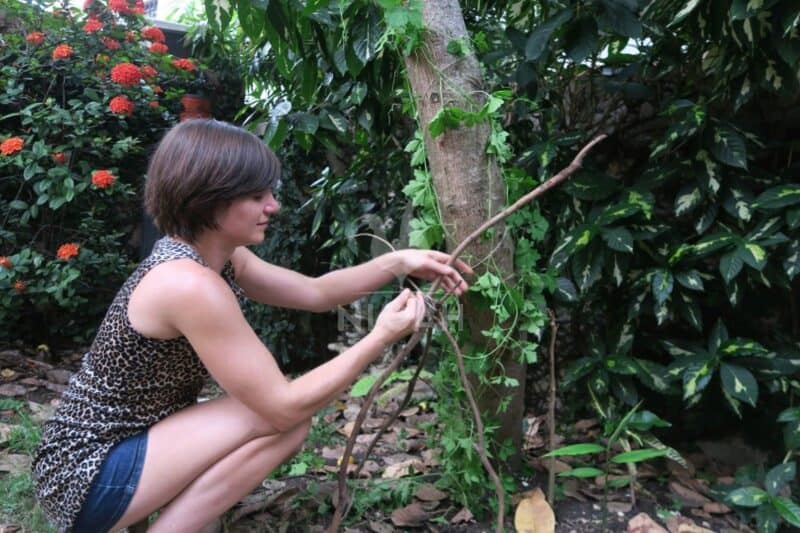
Plant Functions in Guilds
There are a few friendly characters in the guild neighborhoods, all using their unique talents to serve a multitude of functions to keep the guild going.
When you select plants for your guild, you’re aiming to provide solutions to benefit your anchor. Typically, plants are selected to play the following roles, but there are always more you can think of from observing your own garden requirements.
Miners
Miners are animals and plants that work within your guild to mine from the soil. The different layers of soil have ranging nutrients, with some of the best minerals deep down below the surface – usually too far down for most crops to reach.
Adding miner plants to your guild will enhance your soil as their long taproot reaches down further than other species and harvests minerals from deep down. As leaves drop from these miners and decay, the minerals are released into the topsoil – providing food for the anchor crop.
Typically used edible and medicinal miner plants include borage, dandelion, carrots, beets, cassava, and sweet potatoes. In general, plants with big floppy leaves and a long, deep central root tend to do this job.
Animals and insects can also serve as diggers, burrowing through the soil and turning over nutrients. Worms, for example, will help to decompose organic material, leaving nutrient-rich work castings in their wake. Ants, termites, and beetles also do this.
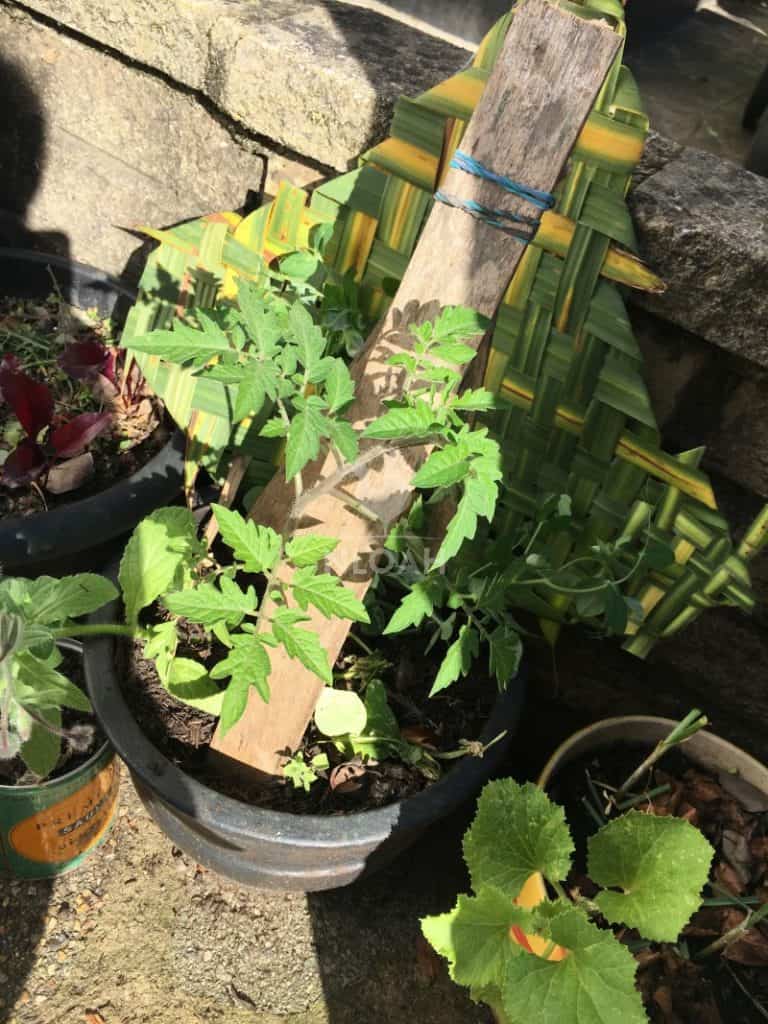
Nitrogen Fixers
Plants need nitrogen to grow big and strong, as well as to effectively complete photosynthesis. This is why one of the 3 ingredients of fertilizer is nitrogen.
Rather than spraying crops, we can incorporate nitrogen-fixing plants that capture N2 from the atmosphere and deposit it into the soil through leaf drops (some say just by growing there).
If you’re looking to plant a nitrogen-fixer, legumes are your first port of call – both edible and non-edible. Nitrogen-fixing crops include peas, beans, lentils, rooibos, fenugreek, alfalfa, clover, and lupinus.
Groundcover
Groundcover is used to protect the soil from the natural elements – sun, wind, rain, etc. By covering the soil, groundcovers insulate the ground for better growing conditions, while preventing weeds from coming through.
Groundcover stops the sun from beating down and evaporating all the water, helping the soil retain moisture. Groundcover can also condition the soil (if it’s an N2 fixer), providing green mulch.
Groundcovers can also be edible, as well as part of your integrated pest management and as a weed suppressant.
There are 5 types of groundcovers used in guilds: herbaceous plants, shrubs, moss, grass, and vines or creepers.
Commonly gardeners use creeping thyme, alpine strawberries, mint, creeping rosemary, wintergreen, oregano, comfrey, red clover, lentils. Crops like squashes and cucumbers also have big fan leaves which can shade the soil.
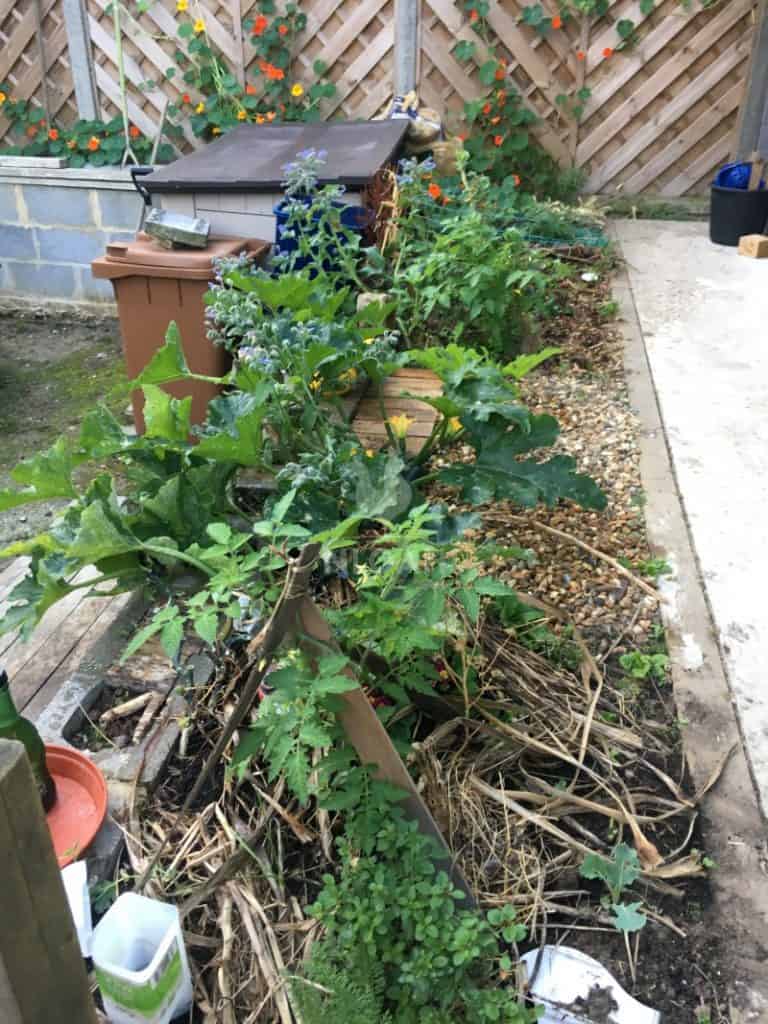
Structural Aids
Structural aids provide physical support to enhance the growing conditions for plants. The most obvious example of this is having plants serve as living trellises for creepers and climbers or as support poles for crops such as tomatoes.
Plants used in this way are corn, sunflowers, and small fruit trees. You can also incorporate non-living elements, such as birdbaths, bat boxes on poles, bird feeders, and stone walls.
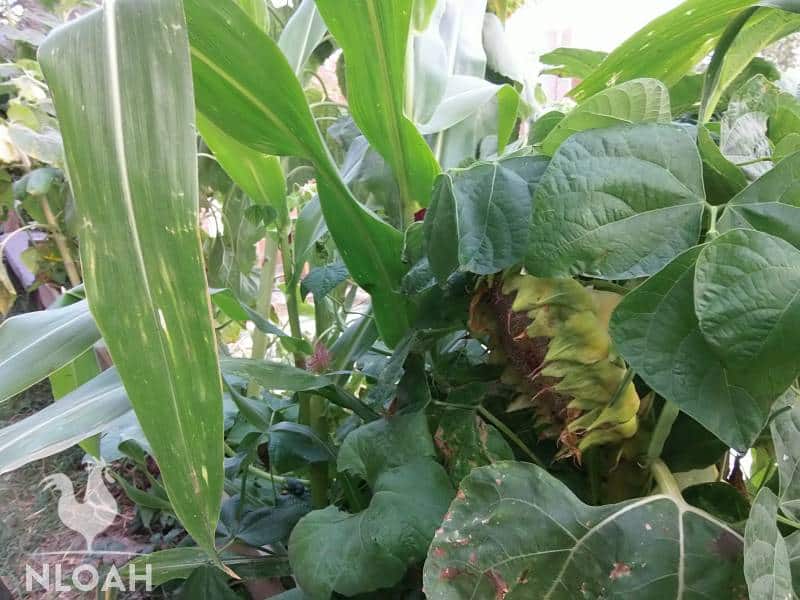
Remember that if your tree is a fruit or nut-producing anchor and you also use it as a supporting trellis for a climber – you run the risk of cutting off the tree’s production if the climber gets out of hand.
Protectors
Protectors come in many forms in your guild. Think of the many threats to your crops – protectors are primed to tackle these problems, collaborating in unison.
Protectors can take the shape of integrated pest management devices.
Perhaps you incorporated borage with your tomatoes to deter tomato hornworm, for example. Maybe you sink a few alliums in too, to stave off pests with their heavy scent.
You also plant basil to prevent aphids and hornworms, and fennel a little further out to lure hornworms away. Marigolds can also be thrown into the mix as they kill nematodes with the toxin they shed from their roots.
In this example, we have an edible harvest of tomatoes, fennel, basil, onions/garlic, marigold, and borage petals plus basil, borage leaves and flowers, marigold flowers, fennel, and garlic. All the while – your protector plants manage your pest control automatically to protect your anchor tomato plant.
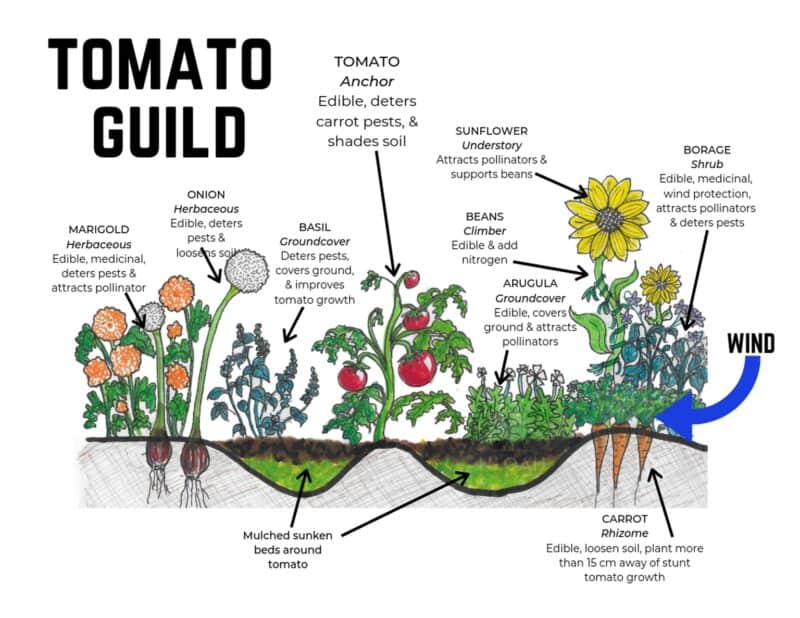
Protectors can also come into play for soil protection. When we leave our soil bare, it is at the mercy of the elements.
The sun, while great for plant growth, beats down on the soil, evaporating moisture – leaving our plants thirsty. The light, loamy soil dries – this is swept away by the wind, leaving behind exposed roots and the lower, hardy clay soils.
When rainfall comes, it cannot penetrate the harder soil. The plants suffer without water and the run-off slides away. When the sun comes again, the soil is hardened and dried further and the process (of desertification) continues.
Protector plants prevent this from happening.
Say for example that you plant a tomato, and you also plant a squash. The squash has big leaves that provide shade for the soil to insulate it and lock in moisture.
Next, we plant oregano and creeping thyme as a ground cover to hold the soil to prevent erosion and to shade the soil from the sun. Taller, bushier oregano or a thicket of broad beans can provide a wind guard for your tomatoes.
Here, you have an edible yield of tomatoes, squash, thyme, and oregano, with medicinal uses for the herbs as well – while retaining moisture in the soil, and shielding your tomatoes from soil erosion and wind.
Protector plants may also serve to suppress weeds. Plants that have dense root systems are great bordering plants to hold back weeds – such as cress, garlic lemongrass, and rhizomes like ginger, turmeric, and cassava. Equally creeping or low-level groundcovers that shade the soil will keep the weed population at bay.
As with the example above, the squash, thyme, oregano, garlic, and borage are all working to keep the weeds back. Salad leaves such as arugula and mustard leaves work here too.
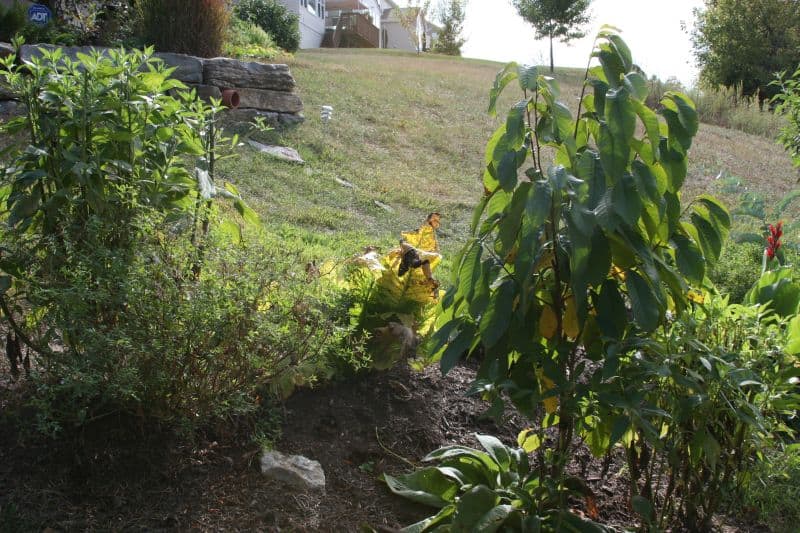
Helpful Tips for Guilds
Here are a few extra handy hints to make sure you’re building reliable guilds:
Know your companions
While some companions work to support your anchor, some may not help. Unfortunately, you may find a great ground cover for the space, then find that it stumps the growth of another player in the guild. Do your research beforehand to know your bad neighbors.
Don’t forget time
This has been mentioned above, but people often forget to manage their design over time. Make sure that you have crop rotation systems in place and reminders to plant just before the last crop has finished. This keeps the nutrient cycling in the soil.
Equally, don’t forget how big things grow. It can be too easy to let creepers run away and bushy shrubs to bulk out – ensure you’ve considered how your guild will look over time to prevent your anchor from getting overcrowded.
Read the weeds
Weeds are the pioneers of the forest. They are nature’s way of starting again. By considering weed patterns, you can tell what the soil needs and in what ratios.
Say you notice 50% of the surrounding ground of your anchor tree is covered in nitrogen-fixing nettles – you know you need a heavy dose of nitrogen among your companions.
Analyze your anchor plant
Many people forget to consider the produce and properties of their anchor plant.
If you have heavy fruits like melons and squashes climbing up a slender young tree, they will bend and break it. If your anchor tree continuously drops heavy apples on delicate flowers below, they will kill them. Think about the fall zone, when this will happen, and what it might affect.
It’s okay to plant the plants you love, too!
While you’ll want to pay attention to the guidelines listed above in terms of where to place these species, it’s okay to plant just about anything in your new guild.
To conclude…
Guilds are an inspiringly intelligent planting pattern that increases the yield of your crops while protecting and supporting them using other plants and elements. By leveraging the natural benefits of certain plants, you can create a self-balancing ecosystem that’s abundant and resilient.
Choose your companions wisely, observe your environment, and harness forest gardening techniques to manage pest control, wind and sun conditions, weeds, water flow, and so on.
Not only will you end up with healthy crops, you’ll also have a diverse range of perennials to add to your diet and medicine cabinet!
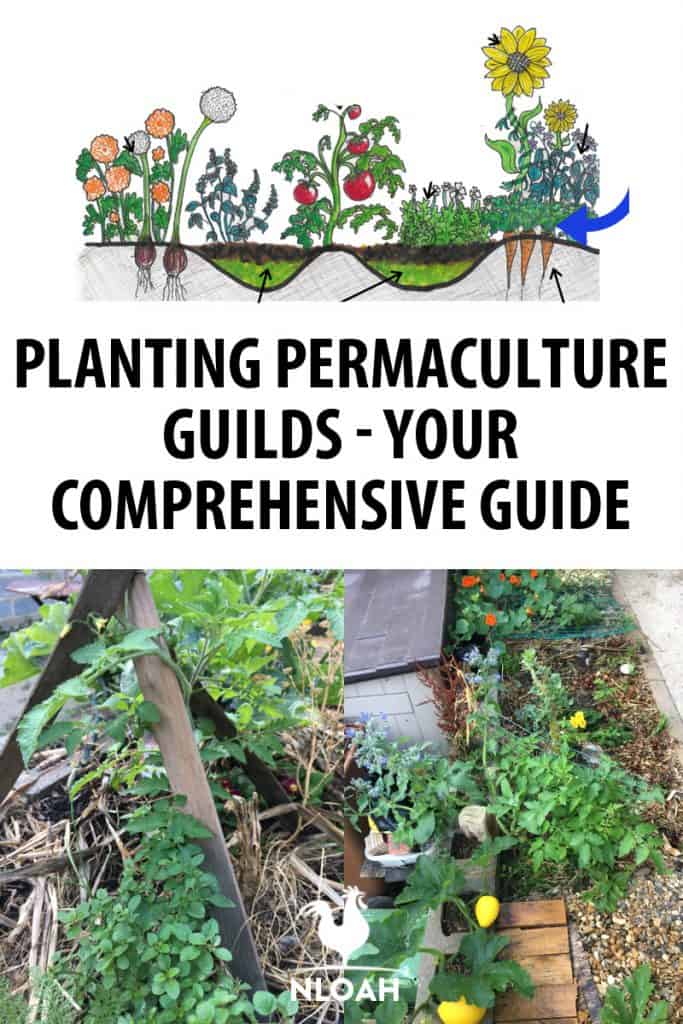
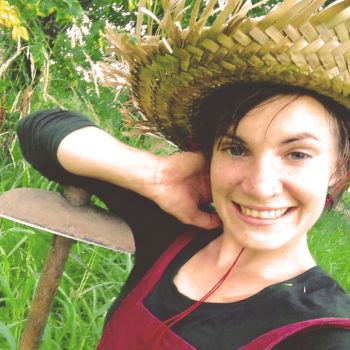
Emmy Jenkins, AKA Permie Emmy, has spent many years traveling around the globe and working remotely, dipping her toes into a myriad of disciplines. Having spent several years volunteering on sustainable farms, Emmy chose to delve deeper into permaculture theory to understand the social and economic patterns often neglected in the philosophy. When she’s not planting edible gardens and frolicking the jungle, she’s consulting on projects around the world to help permaculturalists to understand regenerative ‘Fairshare’ economic patterns and to encourage People Care patterns that focus on biomimicry.

Can you do an article on guild examples…?
Wow “read your weeds” is such brilliant advice! Never seen it before and it just makes so much sense. Thank very much for your input generally speaking. It was a great article.
This is v clear and informative, and useable, thankyou.